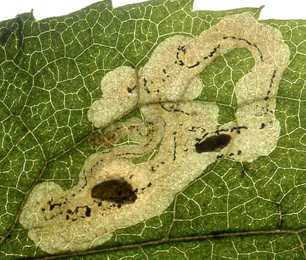|
||||||
|
Phytomyza
solidaginis Hendel, 1920 Phytomyza
solidaginis Hendel, 1920. Arch. Naturgesch. 84A(7)
(1918):159, 160 |
|||||||||||||||||||||||||||||||||||||||||||||||||||||||||||||||||||||||||
Leaf-miner: A conspicuous white mine with frass in more or less connected strips, older mines can show a conspicuous reddish-violet discolouration (Spencer, 1972b: 76 (fig. 253), 80; Spencer, 1976: 501). Upper surface corridor, 6-9 cm in length, densely wound, easily confluent into a secondary blotch. Frass unusual, in more or less connected strings at either side of the corridor. Pupation outside the mine, exit slit usually in the upper epidermis. According to Hering dried mines turn yellow brown to reddish purple (Bladmineerders van Europa).
Larva: The larvae of flies are leg-less maggots without a head capsule (see examples). They never have thoracic or abdominal legs. They do not have chewing mouthparts, although they do have a characteristic cephalo-pharyngeal skeleton (see examples), usually visible internally through the body wall. The larva is described by de Meijere (1926, 1928 and 1938a); see also Griffiths (1976c). Puparium: The puparia of flies are formed within the hardened last larval skin or puparium and as a result sheaths enclosing head appendages, wings and legs are not visible externally (see examples). Black; posterior spiracles each with an ellipse of 10-17 bulbs Spencer, 1976: 501). Hosts in Great Britain and Ireland:
Hosts elsewhere:
Time of year - mines: August-September. Time of year - adults: Currently unknown. Distribution in Great Britain and Ireland: Widespread in Britain including Kent (Darenth) (Spencer, 1972b: 80); East Gloucestershire, Glamorgan, North Ebudes and West Gloucestershire (NBN Atlas). Distribution elsewhere: Widespread in continental Europe including Belgium (de Bruyn and von Tschirnhaus, 1991), Germany (Spencer, 1976: 578), Finland, Norway, Sweden (Spencer, 1976: 501), Poland (Spencer, 1990: 274) and Estonia (Fauna Europaea). NBN Atlas links to known host species:
British and Irish Parasitoids in Britain and elsewhere:
|
|
|
|
| External links: | Search the internet: |
Biodiversity Heritage Library |
Find
using Google Find using Google Scholar Find images using Google |
| Last updated 10-Jul-2019 Brian Pitkin | ||

